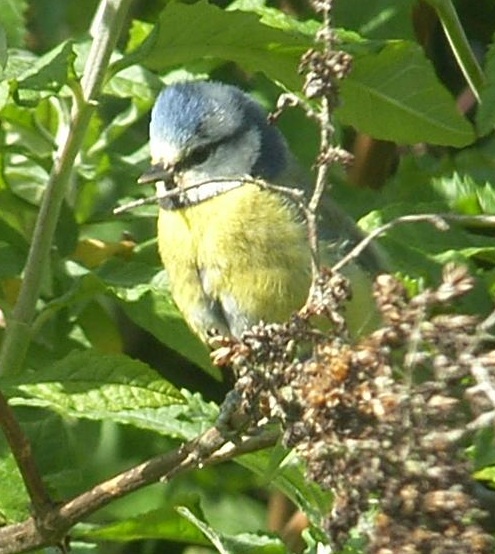Blue Tit
Scientific name: Cyanistes caeruleus syn Parus caeruleus

A Blue Tit with its distinctive blue cap.
Blue Tits are common garden birds often seen performing acrobatic feats as they extract nuts and seeds from bird feeders. They are usually the first to take from new sources of food, for example a new garden feeder. In earlier times when doorstep milk deliveries were the norm, they were known for their ability to pick through the aluminium bottle tops to get at the cream. Another bad habit is to destroy young leaf buds of trees to find hidden insects.
They prefer more protein-rich spiders and insects, especially during the breeding season, and a pair of them can account for about 10,000 caterpillars and a million aphids annually; they will also take scale insects.
They are about 11 to 12cm long with a wingspan of 17 to 20cm. The bright blue cap is their distingushing feature, along with a black eye-stripe in white cheeks. The yellow belly has a black stripe, and the wings and tail are blue. Both sexes are similarly marked, though the female is a little paler; fledglings are duller with yellow cheeks.
Breeding occurs from mid-April to July. They build nests from moss, wool, feathers and hair in small holes in trees, walls or suitably-placed nest boxes, with pairs returning to the same site in subsequent years.
The eggs are white with red speckles in clutches of normally 7 or 8. After incubating for 13 to 15 days the eggs hatch and the young are able to fledge 16 to 22 days later. The nest can be raided by weasels and red and grey squirrels.
The process is weather-dependent as colder, wet conditions reduce the amount of caterpillars available to feed the nestlings. The threat of changes to the climate may have an effect on bird numbers, but at present the conservation status of Blue Tits is safe and the RSPB estimate that there are about 3.5 million breeding pairs in the UK.
They are non-migratory, found across Europe and western Asia below the arctic circle. In winter Blue and Great Tits can be found in flocks together.
Back to GARDEN CREATURES
